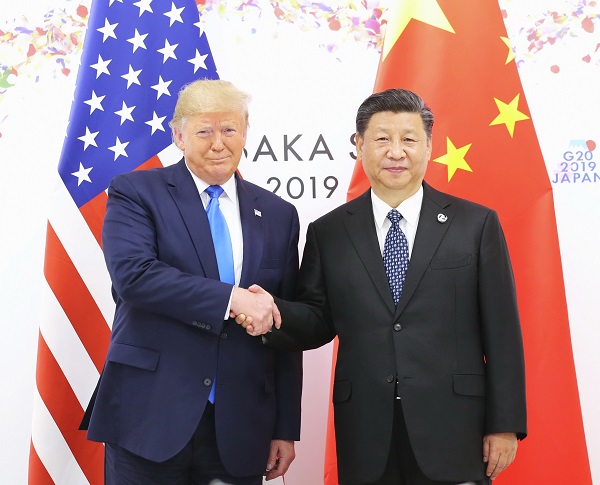
Osaka, US President Donald Trump and his Chinese counterpart Xi Jinping on Saturday agreed to resume trade negotiations in an effort to end the impasse between the world’s two largest economies, with Beijing saying that now Washington will not impose any new tariffs on its goods.
Speaking to the media after his highly anticipated meeting with Xi on the sidelines of the ongoing G20 summit here, Trump said: “We had a very good meeting with President Xi of China. Excellent, I would say excellent. As good as it was going to be.
“We discussed a lot of things and we’re right back on track and we’ll see what happens,” he said, without elaborating.
According to Trump, Washington would not implement new tariffs on $300 billion of Chinese imports “at least for the time being” and that negotiations to end their year-long trade war would resume, the South China Morning Post reported.
He also announced that American companies could sell to Chinese telecommunications equipment giant Huawei again as long as the sales did not involve equipment that threatened US national security. This effectively ends the current ban on US company sales to Huawei.
The US and China have been fighting a damaging trade war over the last year. Trump accuses China of stealing intellectual property and forcing US firms to share trade secrets in order to do business in China.
Beijing, in turn, says Washington’s demands for business reform are “unreasonable”. The feud escalated in the months leading up to the summit after talks between the two countries collapsed in May.
According to Xinhua news agency, Trump and Xi agreed to carry out the consultations “on the basis of equality and mutual respect”, a condition put forward by the Chinese leader for reaching a deal in earlier trade negotiations.
Xi said that despite changes that have taken place internationally and between China-US relations over the past 40 years, “one basic fact remains unchanged: China and the US both benefit from cooperation and lose in confrontation”.
“Cooperation and dialogue are better than friction and confrontation,” Xi said at the start of the meeting, adding that he wanted to maintain frequent contact with the US President to boost stable bilateral relations.
The meeting showed both leaders’ apparent willingness to restart discussions after the breakdown in negotiations in May and the subsequent exchange of tariff increases.
The truce suggests that the two sides will not impose fresh measures to worsen the situation, but it remains to be seen whether they are really ready to make concessions to reach a final deal.
There has been no agreement yet on key issues such as the difficulties US companies face in accessing the Chinese market, or once there, the handicaps they face against state enterprises, subsidized by Beijing.
Common ground has also been missing on intellectual property rights, the forced transfer of technology or cyber security – topics that the two sides are expected to discuss in the coming months.
The Washington-Beijing tensions have their origins in the large US trade deficit with China, as the latter exports products worth $419 billion more than it imports from its biggest trading partner, the US.
The last chapter of escalation in the conflict unfolded in May when the US raised tariffs to 25 per cent on Chinese imports worth $200 billion, to which Beijing responded by raising tariffs on US products worth $60 billion.









